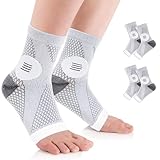Key Takeaways For Best Circulation Socks
Best circulation socks improve blood flow and reduce swelling in the feet and legs.
They feature graduated compression and breathable materials for comfort during wear.
With various sizes and styles available, finding the perfect circulation socks for your needs is easy and effective.
Top Circulation Socks
Circulation socks, also known as compression socks or compression stockings, have become increasingly popular for their ability to enhance blood circulation, reduce swelling, and alleviate discomfort in the legs and feet. Whether you’re an athlete aiming to improve performance or someone seeking relief from the symptoms of poor circulation, choosing the right circulation socks can significantly impact your overall comfort and well-being. In this comprehensive guide, we will delve into the world of circulation socks, discussing their benefits, key features to consider, and top recommendations to help you find the perfect pair for your needs.
Understanding Circulation Socks
Before we dive into specifics, let’s take a closer look at what circulation socks are and how they work:
What are Circulation Socks?
Circulation socks are specially designed garments that apply gentle pressure to the legs and feet, helping to improve blood flow and circulation. They are typically made from elastic materials that compress the veins and muscles, aiding blood return to the heart.
How do Circulation Socks Work?
Circulation socks work by applying graduated compression, meaning the pressure is highest at the ankle and gradually decreases towards the top of the sock. This compression helps push blood upwards, reducing blood pooling in the lower extremities and preventing swelling and discomfort.
Benefits of Circulation Socks
Circulation socks offer a wide range of benefits for individuals of all ages and activity levels:
1. Improved Blood Circulation
By applying gentle pressure to the legs and feet, circulation socks help improve blood flow, delivering oxygen and nutrients more efficiently to the muscles and tissues.
2. Reduced Swelling and Edema
The compression provided by circulation socks helps to prevent fluid retention in the legs and feet, reducing swelling and oedema commonly associated with conditions like varicose veins and deep vein thrombosis (DVT).
3. Alleviation of Leg Fatigue and Discomfort
Wearing circulation socks can help reduce feelings of heaviness, fatigue, and discomfort in the legs and feet, particularly after long periods of standing or sitting.
4. Prevention of Blood Clots
Circulation socks can help reduce the risk of developing blood clots by promoting blood flow and preventing blood from pooling in the veins, a common risk factor for clot formation.
Key Features to Consider
When selecting the best circulation socks for your needs, consider the following key features:
1. Compression Level
Circulation socks are available in various compression levels, ranging from mild to moderate to firm. Choose a compression level that suits your activity level and specific health needs.
2. Material and Construction
Look for circulation socks made from breathable, moisture-wicking materials that provide comfortable support without feeling too restrictive or uncomfortable.
3. Fit and Comfort
Ensure the circulation socks fit snugly but comfortably around your legs and feet without binding or pinching. Opt for socks with seamless construction and cushioned soles for comfort during prolonged wear.
4. Durability and Maintenance
Choose circulation socks that are durable and easy to care for, with reinforced seams and high-quality materials that can withstand repeated use and washing.
Top Picks for the Best Circulation Socks
Now, let’s explore some top recommendations for the best circulation socks available on the market:
1. Everyday Compression Socks
These socks are designed for daily wear and provide mild to moderate compression to promote circulation and reduce swelling and discomfort in the legs and feet.
2. Athletic Compression Socks
Ideal for athletes and active individuals, these socks offer targeted compression and support to enhance performance and speed up recovery after workouts or competitions.
3. Medical-grade Compression Socks
Recommended for individuals with specific medical conditions such as venous insufficiency or lymphedema, these socks provide firm compression to alleviate symptoms and improve overall circulation.
4. Travel Compression Socks
Designed for long-distance travel, these socks help prevent swelling and discomfort in the legs and feet during extended periods of sitting or standing.
Elevate Your Comfort and Circulation with Circulation Socks
Whether you’re looking to improve blood flow, reduce swelling, or alleviate discomfort in your legs and feet, circulation socks offer an effective and convenient solution. With the right pair of circulation socks, you can enjoy enhanced comfort and well-being in your daily activities. Consider the features and recommendations outlined above to find the best circulation socks for your needs and experience the benefits of better circulation firsthand.
Frequently Asked Questions about Best Circulation Socks
What are circulation socks?
Circulation or compression socks are specially designed garments that apply gentle pressure to the legs and feet to improve blood circulation. They are often used to reduce swelling, prevent blood clots, and alleviate symptoms of circulation-related conditions such as oedema, varicose veins, and deep vein thrombosis (DVT).
What are the benefits of wearing circulation socks?
Wearing circulation socks offers several benefits, including:
- Improved blood flow: Circulation socks help enhance circulation by applying graduated pressure to the legs and feet, which can reduce swelling and prevent blood from pooling in the veins.
- Reduced swelling: Circulation socks can help reduce swelling in the legs and feet by promoting fluid movement out of the tissues and back into the bloodstream.
- Prevention of blood clots: Circulation socks are commonly used to prevent the formation of blood clots, especially during long periods of sitting or standing, such as during air travel or extended work periods.
- Alleviation of symptoms: Circulation socks can help alleviate symptoms of circulation-related conditions such as achiness, heaviness, and fatigue in the legs and feet.
- Enhanced comfort: Circulation socks offer support and cushioning for the legs and feet, making them comfortable for everyday activities or travelling.
Who can benefit from wearing circulation socks?
Circulation socks can benefit a wide range of individuals, including:
- Those with circulation-related conditions: Individuals with conditions such as oedema, varicose veins, DVT, or lymphedema can benefit from wearing circulation socks to improve blood flow and reduce swelling.
- Frequent travellers: People who frequently travel, especially by air, can benefit from wearing circulation socks to prevent blood clots and reduce the risk of swelling and discomfort during long flights.
- Athletes and active individuals often wear circulation socks during workouts or competitions to improve circulation, reduce muscle fatigue, and enhance performance.
- Individuals who stand or sit for long periods: People who stand or sit for extended periods, such as healthcare workers, office workers, or pregnant women, can benefit from wearing circulation socks to prevent swelling and alleviate discomfort in the legs and feet.
How do I choose the best circulation socks?
When selecting circulation socks, consider the following factors:
- Compression level: Choose the appropriate level of compression based on your needs and preferences. Compression levels are typically measured in millimetres of mercury (mmHg), with higher numbers indicating firmer compression.
- Size and fit: Ensure the circulation socks fit snugly but comfortably around your legs and feet without being too tight or restrictive. Refer to the manufacturer’s sizing chart to find the correct size for your measurements.
- Material: Look for circulation socks made from breathable and moisture-wicking materials such as nylon, spandex, or polyester, which help keep your feet dry and comfortable throughout the day.
- Purpose: Choose circulation socks designed for your specific needs, whether medical-grade compression for a specific condition, athletic compression for sports performance, or travel compression for long-distance travel.
How do I wear and care for circulation socks?
To wear and care for circulation socks effectively, follow these tips:
- Putting on: Roll the circulation socks down to the heel, then gently pull them up over your foot and calf, ensuring the fabric is smooth and evenly distributed without wrinkles or bunching.
- Wearing: Wear circulation socks during the day or as your healthcare provider recommends. Avoid wearing them while sleeping unless expressly advised to do so.
- Cleaning: Wash circulation socks by hand or machine using mild detergent and lukewarm water. Avoid using bleach or fabric softeners, which can damage the compression fibres. Air dry or lay flat to dry, avoiding direct heat or sunlight.
- Replacing: Replace circulation socks as needed, typically every 3 to 6 months or when they lose elasticity or compression effectiveness. Follow the manufacturer’s recommendations for proper care and replacement intervals to ensure optimal performance.
Top Circulation Socks
Explore More on Leg Health and Circulation Aids
- Best Circulation Exercises for Legs – Discover effective exercises to improve circulation and leg health.
- Fix Poor Circulation in Your Feet – Learn practical tips for enhancing circulation in your feet.
- Foot Circulation Questions and Answers – Get answers to common questions regarding foot and leg circulation issues.
- Best Compression Boots – Explore top compression boots for promoting blood flow and muscle recovery.






